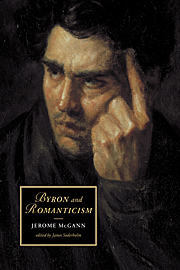Book contents
- Frontmatter
- Contents
- Acknowledgments
- General analytical and historical introduction
- PART I
- 1 Milton and Byron
- 2 Byron, mobility, and the poetics of historical ventriloquism
- 3 “My brain is feminine”: Byron and the poetry of deception
- 4 What difference do the circumstances of publication make to the interpretation of a literary work?
- 5 Byron and the anonymous lyric
- 6 Private poetry, public deception
- 7 Hero with a thousand faces: the rhetoric of Byronism
- 8 Byron and the lyric of sensibility
- 9 Byron and Wordsworth
- PART II
- Subject index
- Authors index
- CAMBRIDGE STUDIES IN ROMANTICISM
8 - Byron and the lyric of sensibility
Published online by Cambridge University Press: 22 September 2009
- Frontmatter
- Contents
- Acknowledgments
- General analytical and historical introduction
- PART I
- 1 Milton and Byron
- 2 Byron, mobility, and the poetics of historical ventriloquism
- 3 “My brain is feminine”: Byron and the poetry of deception
- 4 What difference do the circumstances of publication make to the interpretation of a literary work?
- 5 Byron and the anonymous lyric
- 6 Private poetry, public deception
- 7 Hero with a thousand faces: the rhetoric of Byronism
- 8 Byron and the lyric of sensibility
- 9 Byron and Wordsworth
- PART II
- Subject index
- Authors index
- CAMBRIDGE STUDIES IN ROMANTICISM
Summary
In our recent revaluations of Romanticism we have certainly neglected Byron's lyric work – a signal neglect since his influence on nineteenth-century lyric was so great. But to take up this topic is also quickly to discover that the issues involved are large ones. When you open the subject of Byron's lyric poetry, you reopen the subject of Romantic forms in general.
It is a commonplace of literary history that Romanticism instituted a poetic renewal, in particular a renewal of the lyric. With the coming of modernism, when another upheaval of poetic imagination took place, Romantic forms came under severe critical scrutiny. The critique focused on the conventions of Romantic subjectivity and the idea – or the ideology – of “spontaneous overflow.” Those two famous “fallacies” of writing – “the intentional fallacy” and “the affective fallacy” – are obverse and reverse of the same coin. The one is a warning to critics, the other a warning to poets: “Beware Romanticism.”
I recall these matters in order to supply a background for M. H. Abrams's celebrated essay “Structure and Style in the Greater Romantic Lyric.” His argument doesn't need rehearsing. Briefly, Abrams drew on New Critical approaches to seventeenth-century poetry (in particular its various “poetries of meditation”) to fashion his influential description of Romantic lyric form. The persuasiveness of Abrams's essay comes partly from his excellent analysis of a special kind of lyric – the express subject of the essay – and partly from an oblique set of moves to avoid the main line of modernist attack.
- Type
- Chapter
- Information
- Byron and Romanticism , pp. 160 - 172Publisher: Cambridge University PressPrint publication year: 2002

